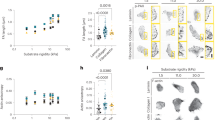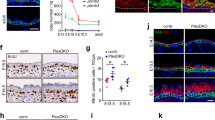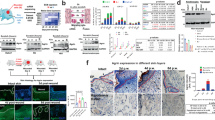Abstract
Laminin-332 is a major component of the dermo-epidermal skin basement membrane and maintains skin integrity. The transduction of mechanical force into electrical signals by sensory endings in the skin requires mechanosensitive channels. We found that mouse epidermal keratinocytes produce a matrix that is inhibitory for sensory mechanotransduction and that the active molecular component is laminin-332. Substrate-bound laminin-332 specifically suppressed one type of mechanosensitive current (rapidly adapting) independently of integrin-receptor activation. This mechanotransduction suppression could be exerted locally and was mediated by preventing the formation of protein tethers necessary for current activation. We also found that laminin-332 could locally control sensory axon branching behavior. Loss of laminin-332 in humans led to increased sensory terminal branching and may lead to a de-repression of mechanosensitive currents. These previously unknown functions for this matrix molecule may explain some of the extreme pain experienced by individuals with epidermolysis bullosa who are deficient in laminin-332.
This is a preview of subscription content, access via your institution
Access options
Subscribe to this journal
Receive 12 print issues and online access
$209.00 per year
only $17.42 per issue
Buy this article
- Purchase on Springer Link
- Instant access to full article PDF
Prices may be subject to local taxes which are calculated during checkout








Similar content being viewed by others
References
Aumailley, M., Has, C., Tunggal, L. & Bruckner–Tuderman, L. Molecularbasis of inherited skin-blistering disorders, and therapeutic implications. Expert Rev. Mol. Med. 8, 1–21 (2006).
Marinkovich, M.P. Tumour microenvironment: laminin 332 in squamous-cell carcinoma. Nat. Rev. Cancer 7, 370–380 (2007).
Uitto, J. & Richard, G. Progress in epidermolysis bullosa: genetic classification and clinical implications. Am. J. Med. Genet. 131C, 61–74 (2004).
Aumailley, M. et al. A simplified laminin nomenclature. Matrix Biol. 24, 326–332 (2005).
Tomaselli, K.J. et al. Expression of beta 1 integrins in sensory neurons of the dorsal root ganglion and their functions in neurite outgrowth on two laminin isoforms. J. Neurosci. 13, 4880–4888 (1993).
Lewin, G.R. & Moshourab, R. Mechanosensation and pain. J. Neurobiol. 61, 30–44 (2004).
Kruger, L., Silverman, J.D., Mantyh, P.W., Sternini, C. & Brecha, N.C. Peripheral patterns of calcitonin gene–related peptide general somatic sensory innervation: cutaneous and deep terminations. J. Comp. Neurol. 280, 291–302 (1989).
Zylka, M.J., Rice, F.L. & Anderson, D.J. Topographically distinct epidermal nociceptive circuits revealed by axonal tracers targeted to Mrgprd. Neuron 45, 17–25 (2005).
Halata, Z. The Mechanoreceptors of the Mammalian Skin Ultrastructure and Morphological Classification (Springer-Verlag, Berlin, 1975).
Sinclair, D. Mechanisms of Cutaneous Sensation (Oxford University Press, 1981).
Bruckner-Tuderman, L. Biology of the extracellular matrix. in Dermatology (eds. Bologna, J. & Jorizzo, J.L.) 1483–1496 (Mosby, London, 2003).
Hu, J., Chiang, L.Y., Koch, M. & Lewin, G.R. Evidence for a protein tether involved in somatic touch. EMBO J. 29, 855–867 (2010).
Lechner, S.G., Frenzel, H., Wang, R. & Lewin, G.R. Developmental waves of mechanosensitivity acquisition in sensory neuron subtypes during embryonic development. EMBO J. 28, 1479–1491 (2009).
Wetzel, C. et al. A stomatin-domain protein essential for touch sensation in the mouse. Nature 445, 206–209 (2007).
Hu, J. & Lewin, G.R. Mechanosensitive currents in the neurites of cultured mouse sensory neurones. J. Physiol. (Lond.) 577, 815–828 (2006).
Drew, L.J. & Wood, J.N. FM1–43 is a permeant blocker of mechanosensitive ion channels in sensory neurons and inhibits behavioral responses to mechanical stimuli. Mol. Pain 3, 1 (2007).
Drew, L.J. et al. High-threshold mechanosensitive ion channels blocked by a novel conopeptide mediate pressure-evoked pain. PLoS ONE 2, e515 (2007).
Drew, L.J., Wood, J.N. & Cesare, P. Distinct mechanosensitive properties of capsaicin-sensitive and -insensitive sensory neurons. J. Neurosci. 22, RC228 (2002).
McCarter, G.C., Reichling, D.B. & Levine, J.D. Mechanical transduction by rat dorsal root ganglion neurons in vitro. Neurosci. Lett. 273, 179–182 (1999).
Hao, J. & Delmas, P. Multiple desensitization mechanisms of mechanotransducer channels shape firing of mechanosensory neurons. J. Neurosci. 30, 13384–13395 (2010).
Masunaga, T. et al. Localization of laminin-5 in the epidermal basement membrane. J. Histochem. Cytochem. 44, 1223–1230 (1996).
Jensen, K.B., Jensen, O.N., Ravn, P., Clark, B.F. & Kristensen, P. Identification of keratinocyte-specific markers using phage display and mass spectrometry. Mol. Cell. Proteomics 2, 61–69 (2003).
Culley, B. et al. Laminin-5 promotes neurite outgrowth from central and peripheral chick embryonic neurons. Neurosci. Lett. 301, 83–86 (2001).
Rousselle, P., Lunstrum, G.P., Keene, D.R. & Burgeson, R.E. Kalinin: an epithelium-specific basement membrane adhesion molecule that is a component of anchoring filaments. J. Cell Biol. 114, 567–576 (1991).
Xia, Y., Gil, S.G. & Carter, WG. Anchorage mediated by integrin a6134 to laminin-5 (Epiligrin) regulates tyrosine phosphorylation of a membrane–associated 80-kDa protein. J. Cell Biol. 132, 727–740 (1996).
Aumailley, M., El Khal, A., Knoss, N. & Tunggal, L. Laminin-5 processing and its integration into the ECM. Matrix Biol. 22, 49–54 (2003).
Tsuruta, D. et al. Crucial role of the specificity-determining loop of the Integrin β4 subunit in the binding of cells to Laminin-5 and outside-in signal transduction. J. Biol. Chem. 278, 38707–38714 (2003).
Kariya, Y. & Miyazaki, K. The basement membrane protein laminin-5 acts as a soluble cell motility factor. Exp. Cell Res. 297, 508–520 (2004).
Plopper, G. et al. Changes in expression of monoclonal antibody epitopes on laminin-5r induced by cell contact. J. Cell Sci. 109, 1965–1973 (1996).
von Philipsborn, A.C. et al. Microcontact printing of axon guidance molecules for generation of graded patterns. Nat. Protoc. 1, 1322–1328 (2006).
von Philipsborn, A.C. et al. Growth cone navigation in substrate-bound ephrin gradients. Development 133, 2487–2495 (2006).
Lewin, G.R. & McMahon, S.B. Physiological properties of primary sensory neurons appropriately and inappropriately innervating skin in the adult rat. J. Neurophysiol. 66, 1205–1217 (1991).
Amano, S. et al. Bone morphogenetic protein 1 is an extracellular processing enzyme of the laminin 5 gamma 2 chain. J. Biol. Chem. 275, 22728–22735 (2000).
Simone, D.A., Nolano, M., Johnson, T., Wendelschafer–Crabb, G. & Kennedy, W.R. Intradermal injection of capsaicin in humans produces degeneration and subsequent reinnervation of epidermal nerve fibers: correlation with sensory function. J. Neurosci. 18, 8947–8959 (1998).
Herod, J., Denyer, J., Goldman, A. & Howard, R. Epidermolysis bullosa in children: pathophysiology, anaesthesia and pain management. Paediatr. Anaesth. 12, 388–397 (2002).
Fine, J.D., Johnson, L.B., Weiner, M. & Suchindran, C. Assessment of mobility, activities and pain in different subtypes of epidermolysis bullosa. Clin. Exp. Dermatol. 29, 122–127 (2004).
Nishimune, H., Sanes, J.R. & Carlson, S.S. A synaptic laminin-calcium channel interaction organizes active zones in motor nerve terminals. Nature 432, 580–587 (2004).
Sann, S.B., Xu, L., Nishimune, H., Sanes, J.R. & Spitzer, N.C. Neurite outgrowth and in vivo sensory innervation mediated by a Ca(V)2.2-laminin beta 2 stop signal. J. Neurosci. 28, 2366–2374 (2008).
Lechner, S.G. & Lewin, G.R. Peripheral sensitization of nociceptors via G protein–dependent potentiation of mechanotransduction currents. J. Physiol. (Lond.) 587, 3493–3503 (2009).
Paladini, R.D. & Coulombe, P.A. Directed expression of keratin 16 to the progenitor basal cells of transgenic mouse skin delays skin maturation. J. Cell Biol. 142, 1035–1051 (1998).
Verrando, P. et al. Keratinocytes from junctional epidermolysis bullosa do adhere and migrate on the basement membrane protein nicein through alpha 3 beta 1 integrin. Lab. Invest. 71, 567–574 (1994).
Dittert, I. et al. Improved superfusion technique for rapid cooling or heating of cultured cells under patch-clamp conditions. J. Neurosci. Methods 151, 178–185 (2006).
Hasko, J.A. & Richardson, G.P. The ultrastructural organization and properties of the mouse tectorial membrane matrix. Hear. Res. 35, 21–38 (1988).
Gara, S.K. et al. Three novel collagen VI chains with high homology to the alpha3 chain. J. Biol. Chem. 283, 10658–10670 (2008).
Fine, J.D. et al. The classification of inherited epidermolysis bullosa (EB): report of the Third International Consensus Meeting on Diagnosis and Classification of EB. J. Am. Acad. Dermatol. 58, 931–950 (2008).
Acknowledgements
We thank members of the Lewin laboratory for advice and comments on the manuscript. H. Thränhardt and A. Wegner provided excellent technical support. We thank R. Bönsch for performing the western blot for laminin-332. We also thank M. Bastmeyer and A. von Philipsborn for their help in establishing the micro-contact printing method in the laboratory. We are grateful to B. Erdmann for help and advice with the TEM experiments. This work was supported by grants from the Deutsche Forschungsgemeinschaft (G.R.L. and M.K.), a Network Epidermolysis Bullosa grant from the Federal Ministry of Education and Research (BMBF, L.B.-T.) and a von Humboldt fellowship (J.H.).
Author information
Authors and Affiliations
Contributions
J.H., L.-Y.C. and K.P. performed the electrophysiology experiments and L.-Y.C. carried out the TEM analysis. B.E.O. and M.K. provided laminin-111/Nidogen complexes and recombinant β3 and γ2. K.P. carried out micro-contact printing with L.-Y.C. and performed time-lapse experiments. K.P. carried out AFM experiments. Neurite outgrowth assays and human skin immunocytochemistry were performed by K.P. with help from N.D. and Y.A.B.S. L.B.-T. provided and characterized the human keratinoctyes. L.-Y.C., J.H., K.P. and G.R.L. planned the experiments and analyzed data. G.R.L. and J.H. wrote the paper.
Corresponding authors
Ethics declarations
Competing interests
The authors declare no competing financial interests.
Supplementary information
Supplementary Text and Figures
Supplementary Results (PDF 4201 kb)
Supplementary Video 1
Neurite outgrowth over laminin/laminin cross-hatched pattern. (AVI 38049 kb)
Supplementary Video 2
Neurite outgrowth over laminin/laminin-332 cross-hatched pattern. (AVI 25049 kb)
Rights and permissions
About this article
Cite this article
Chiang, LY., Poole, K., Oliveira, B. et al. Laminin-332 coordinates mechanotransduction and growth cone bifurcation in sensory neurons. Nat Neurosci 14, 993–1000 (2011). https://doi.org/10.1038/nn.2873
Received:
Accepted:
Published:
Issue Date:
DOI: https://doi.org/10.1038/nn.2873
This article is cited by
-
Single-neuron mechanical perturbation evokes calcium plateaus that excite and modulate the network
Scientific Reports (2023)
-
The dynamic nature of netrin-1 and the structural basis for glycosaminoglycan fragment-induced filament formation
Nature Communications (2023)
-
USH2A is a Meissner’s corpuscle protein necessary for normal vibration sensing in mice and humans
Nature Neuroscience (2021)
-
The mechanosensory neurons of touch and their mechanisms of activation
Nature Reviews Neuroscience (2021)
-
Acid-sensing ion channels: dual function proteins for chemo-sensing and mechano-sensing
Journal of Biomedical Science (2018)



